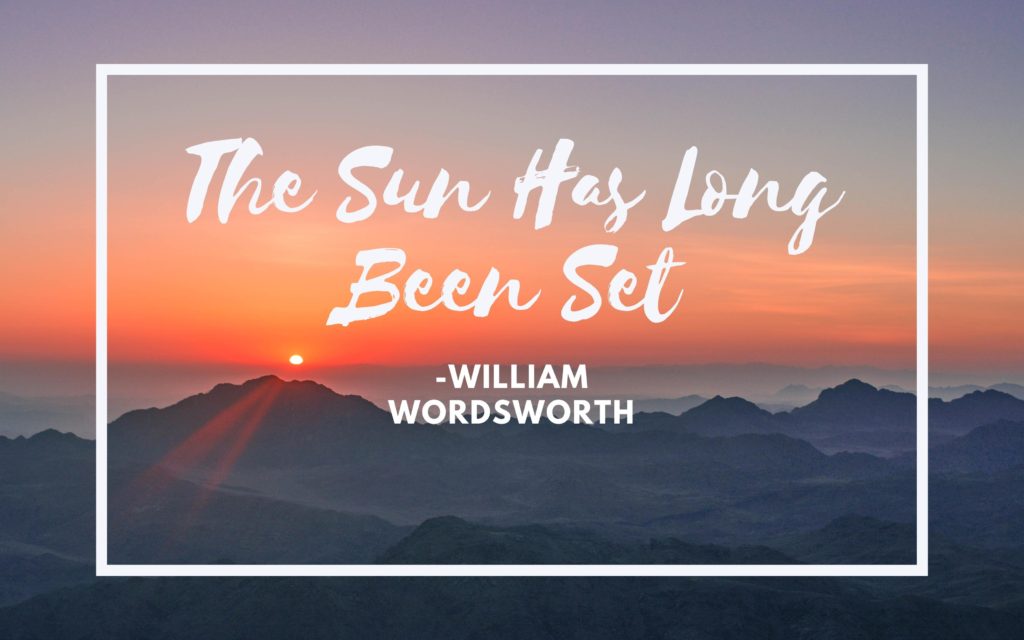This post is about the line by line analysis of The Sun Has Long Been Set written by William Wordsworth. In this post you will find out the complete summary of the poem in an easy to understand language. Moreover you will find some extra information about the poet as well as the poem in this post which you will certainly find helpful. Let us find the line by line analysis of The Sun Has Long Been Set written by William Wordsworth.
The sun has long been set,
The stars are out by twos and threes,
The little birds are piping yet
Among the bushes and trees;
There’s a cuckoo, and one or two thrushes,
And a far-off wind that rushes,
And a sound of water that gushes,
And the cuckoo’s sovereign cry
Fills all the hollow of the sky.
Who would “go parading”
In London, “and masquerading,”
On such a night of June
With that beautiful soft half-moon,
And all these innocent blisses?
On such a night as this is!

ABOUT THE POET
William Wordsworth was an English Romantic pet who had helped to launch the Romantic Age in English Literature. He was born in Cockermouth, U.K., on 7th April 1770.
He took his last breath on 23rd April 1850, at Rydal Mount and Gardens, U.K.
He married Mary Hutchinson and had three children, named Dora, Catherine Wordsworth, and Anne Caroline Wordsworth.
He was one of the founders of English Romanticism and is always remembered as a spirituality port and also a poet with epistemological speculation. Wordsworth’s first poetic study began when he was a kid in grammar school. William Wordsworth is always best known for his ‘Lyrical Ballads’, ‘The Prelude’, and many more.
ABOUT THE POEM
The poem,” The Sun has Long been Set”, is being written by Wordsworth to portray the beauty of setting sun in front of this whole world. He admires the beauty of the nature and also the beauty of that evening or dusk which has worn the ornaments of setting sun in order to be charmer in its own way.
In this poem,” The Sun has Long been Set”, which had also been written by William Wordsworth is about an evening which is about to set in that dark dusk in the sky. The poet expresses his admiration towards the natural beauty of sun set through his poem.
In order to express the beauty of that evening, the poet, through his poem, had even meant that he would have been eagerly go to the party if that setting sun would have invited him. The poem even contains the elements such as moon, stars, sun, evening, night, etc. in order to visualise the natural beauty of the surroundings.
LINE BY LINE ANALYSIS OF THE POEM
INTRODUCTION STANZA
The sun has long been set,
The stars are out by twos and threes,
The little birds are piping yet
Among the bushes and trees;
There’s a cuckoo, and one or two thrushes,
In this very first stanza of the poem, ” The Sun has Long been Set”, the poet wants to portray a vivid picture of the scenario- he is experiencing at that time. The sun had already been set in the sky, welcoming the silent dusk. Few stars were seen in the sky, might be two or three, the birds were chirping all around and we’re returning to there nests, the wind were gushing through the trees and the bushes, and all together, it was a wonderful situation, the poet was witnessing at that point of time. This poem was one of the great works of William Wordsworth during the Romantic era, at the beginning of the 19th century.
MIDDLE STANZA
And a far-off wind that rushes,
And a sound of water that gushes,
And the cuckoo’s sovereign cry
Fills all the hollow of the sky.
Who would “go parading”
In this second stanza of the poem, the poet started to describe the visual beauty of the place. Through his own, we can imagine that the place was carrying a beautiful lake, mountains and forests all around. Thus, we can also say that, our poet was greatly inspired by the portrayal of Love for the Nature and he had used the same in his poem. The pot was so deeply engulfed by the beauty of the Nature that all the imageries he had used in his poem were all realistic and vivid. This gives a clear picture to the reader about the poem and the place all around.
CONCLUDING STANZA
In London, “and masquerading,”
On such a night of June
With that beautiful soft half-moon,
And all these innocent blisses?
On such a night as this is!
The third stanza, or the concluding stanza consists of all hypothetical scenario of the place. The poet has become very sarcastic in these lines of the poem and he emphasizes on the individuality of the Romanticism.
